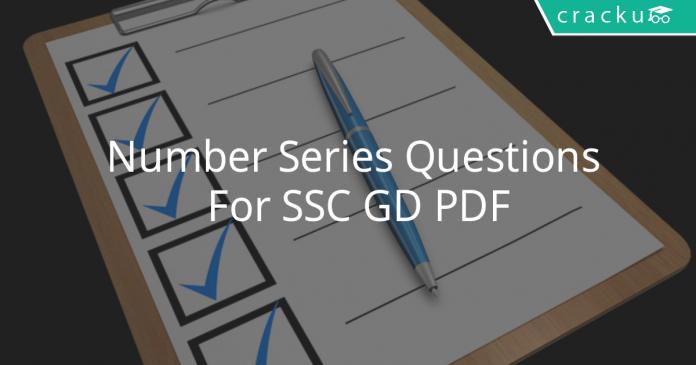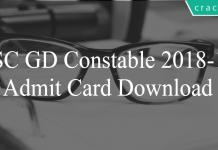Number Series Questions For SSC GD PDF Set – 2
SSC GD Constable Number Series Question and Answers download PDF based on previous year question paper of SSC GD exam. 40 Very important Number Series questions for GD Constable.
NUMBER SERIES QUESTIONS FOR SSC GD PDF
GET 20 SSC GD MOCK FOR JUST RS. 117
Instructions
Select the related word / letters / number from the given alternatives.
Question 1: ABDE GHJK MNPQ
a) RTUW
b) STVW
c) CEFH
d) RSUV
Question 2: If BOY is represented as 42, then GIRL is represented is
a) 46
b) 48
c) 40
d) 43
Instructions
In the following question, select the missing number from the given series.
Question 3: 18, 14, 10, 6, ?
a) 2
b) 3
c) 4
d) 5
Question 4: 8, 11, 14, 17, 20, ?
a) 21
b) 22
c) 23
d) 27
Question 5: 2, 3, 7, 16, 32, ?
a) 57
b) 76
c) 62
d) 67
Question 6: 2, 5, 11, 23, ?
a) 47
b) 45
c) 44
d) 43
Instructions
In the following question, select the missing number from the given series.
Question 7: 263, 277, 290, 302, 313, ?
a) 323
b) 329
c) 321
d) 331
Question 8: 14, 22, 37, 61, 96, ?
a) 152
b) 132
c) 144
d) 162
Question 9: 35, 50, 63, 82, ?, 122
a) 101
b) 99
c) 100
d) None of these
Question 10: 3, 7, 13, 27, 53, ?
a) 107
b) 111
c) 109
d) 105
DOWNLOAD APP TO ACESS DIRECTLY ON MOBILE
Instructions
In the following question, select the missing number from the given series.
Question 11: 2, 3, 10, 39, ?, 1175
a) 196
b) 195
c) 194
d) 193
Question 12: 14, 21, 35, 56, 84, ?
a) 163
b) 143
c) 158
d) None of the above
Question 13: 14, 18, 21, 25, 28, ?
a) 32
b) 31
c) 30
d) 35
Question 14: 17, 19, 22, 24, 27, ?
a) 28
b) 29
c) 30
d) 31
Instructions
In the following question, select the missing number from the given series.
Question 15: 33, 40, 48, 57, 67, ?
a) 80
b) 76
c) 78
d) 81
FREE SSC PRACTICE SET (DAILY TEST)
Question 16: 11, 8, 4, – 1, ?
a) – 5
b) 5
c) – 6
d) – 7
Question 17: 1, 4, 3, 16, 6, 36, 10, 64, 15, 100, ?
a) 21
b) 19
c) 22
d) 25
Question 18: 3, 7, 16, 35, ?
a) 65
b) 72
c) 74
d) 76
Instructions
In the following question, select the missing number from the given series.
Question 19: 16, 17, 25, 52, 116, ?
a) 225
b) 219
c) 241
d) 263
Question 20: 4, 13, 41, 126, 382, ?
a) 1149
b) 1146
c) 1151
d) 1167
Question 21: 1, 9, 25, ?, 361, 841, 1681
a) 169
b) 225
c) 161
d) None of the above
Question 22: 43, 45, 42, 46, 41, 47, ?
a) 41
b) 40
c) 38
d) 42
Instructions
In the following question, select the missing number from the given series.
Question 23: 23, 11, 34, 45, 79, ?
a) 121
b) 124
c) 163
d) 169
Question 24: 9, 19, 37, 75, 149, ?
a) 297
b) 298
c) 300
d) 299
Question 25: 13, 24, 37, 61, 98, ?
a) 159
b) 163
c) 134
d) 172
Question 26: 33, 10, 43, 53, 96, ?
a) 150
b) 163
c) 171
d) 149
Question 27: In the following question, select the missing number from the given series.
102, 85, 68, 51, ?
a) 34
b) 40
c) 37
d) 31
Question 28: In the following question, select the missing number from the given series.
54, 51, 48, 45, 42, ?
a) 38
b) 36
c) 40
d) 39
Question 29: In the number series below which element doesn’t fit in?
512, 772, 1152, 1728, 2592, 3888
a) 1728
b) 772
c) 3888
d) 2592
Question 30: In the number series below which element doesn’t fit in?
78, 101, 124, 147, 169, 193
a) 101
b) 193
c) 169
d) 147
Question 31: Find the wrong number in the series. 14, 16, 19, 24, 31, 42, 51
a) 51
b) 31
c) 19
d) 42
Question 32: Find the wrong number in the series. 8, 11, 20, 47, 130, 371
a) 20
b) 47
c) 130
d) 371
Question 33: In the following question, select the missing number from the given series.
2, 12, 30, 56, ?
a) 87
b) 72
c) 90
d) 110
Question 34: Find the missing number in the series:
24, 25, 52, 159, ?, 3205
a) 640
b) 720
c) 1560
d) 930
Question 35: Find the missing number in the series:
48, 60, 66, ?, 93, 105
a) 70
b) 78
c) 74
d) 80
Question 36: Find the missing number in the series:
6, 6, 12, 36, ?, 720
a) 144
b) 169
c) 120
d) 108
Question 37: – In the following question, select the missing number from the given series.
49, 46, 43, 40, ?, 34
a) 38
b) 37
c) 36
d) 39
Question 38: In the following question, select the missing number from the given series.
19, 9, 28, 37, 65, ?
a) 99
b) 97
c) 102
d) 113
Question 39: In the following question, select the missing number from the given series.
8, 16, 43, 107, 232, ?
a) 342
b) 448
c) 248
d) 528
Question 40: In the following question, select the missing number from the given series.
9, 9, 18, 54, 216, ?
a) 1020
b) 1080
c) 636
d) 740
Answers & Solutions:
1) Answer (B)
Expression : ABDE GHJK MNPQ
Every third letter of the English alphabetical series is omitted, i.e. ‘C,F,I,L,O’ are missing.
Similarly, the next term is = STVW
=> Ans – (B)
2) Answer (A)
If all the letters of English alphabetical series are represented by consecutive natural numbers, i.e., A=1, B=2, C=3 and so on.
=> B=2, O=15, Y=25 $\equiv2+15+25=42$
Similarly, GIRL $\equiv7+9+18+12=46$
=> Ans – (A)
3) Answer (A)
The pattern followed is :
18 – 4 = 14
14 – 4 = 10
10 – 4 = 6
6 – 4 = 2
=> Ans – (A)
4) Answer (C)
The pattern followed is :
8 + 3 = 11
11 + 3 = 14
14 + 3 = 17
17 + 3 = 20
20 + 3 = 23
=> Ans – (C)
5) Answer (A)
The pattern followed is :
2 $+(1)^2$ = 3
3 $+(2)^2$ = 7
7 $+(3)^2$ = 16
16 $+(4)^2$ = 32
32 $+(5)^2$ = 57
=> Ans – (A)
6) Answer (A)
The pattern followed is that numbers of the form $(3\times2^n)$ are added.
2 $+(3\times2^0)$ = 5
5 $+(3\times2^1)$ = 11
11 $+(3\times2^2)$ = 23
23 $+(3\times2^3)$ = 47
=> Ans – (A)
7) Answer (A)
The pattern followed is :
263 + 14 = 277
277 + 13 = 290
290 + 12 = 302
302 + 11 = 313
313 + 10 = 323
=> Ans – (A)
8) Answer (C)
The pattern followed is :
14 $+(3)^2-1$ = 22
22 $+(4)^2-1$ = 37
37 $+(5)^2-1$ = 61
61 $+(6)^2-1$ = 96
96 $+(7)^2-1$ = 144
=> Ans – (C)
9) Answer (B)
The pattern followed is :
$(6)^2-1$ = 35
$(7)^2+1$ = 50
$(8)^2-1$ = 63
$(9)^2+1$ = 82
$(10)^2-1$ = 99
$(11)^2+1$ = 122
=> Ans – (B)
10) Answer (A)
The pattern followed is :
3 $\times2+1$ = 7
7 $\times2-1$ = 13
13 $\times2+1$ = 27
27 $\times2-1$ = 53
53 $\times2+1$ = 107
=> Ans – (A)
11) Answer (A)
The pattern followed is :
2 $\times2-1$ = 3
3 $\times3+1$ = 10
10 $\times4-1$ = 39
39 $\times5+1$ = 196
196 $\times6-1$ = 1175
=> Ans – (A)
12) Answer (D)
The pattern followed is :
14 $+(7\times1)$ = 21
21 $+(7\times2)$ = 35
35 $+(7\times3)$ = 56
56 $+(7\times4)$ = 84
84 $+(7\times5)$ = 119
=> Ans – (D)
13) Answer (A)
‘4’ and ‘3’ are alternatively added.
14 + 4 = 18
18 + 3 = 21
21 + 4 = 25
25 + 3 = 28
28 + 4 = 32
=> Ans – (A)
14) Answer (B)
‘2’ and ‘3’ are alternatively added.
17 + 2 = 19
19 + 3 = 22
22 + 2 = 24
24 + 3 = 27
27 + 2 = 29
=> Ans – (B)
15) Answer (C)
The pattern followed is :
33 + 7 = 40
40 + 8 = 48
48 + 9 = 57
57 + 10 = 67
67 + 11 = 78
=> Ans – (C)
16) Answer (D)
The pattern followed is :
11 – 3 = 8
8 – 4 = 4
4 – 5 = -1
-1 – 6 = -7
=> Ans – (D)
17) Answer (A)
Series : 1, 4, 3, 16, 6, 36, 10, 64, 15, 100, ?
The pattern followed is that there are 2 alternate series.
1st : 4, 16, 36, 64, 100 = Squares of consecutive even numbers.
2nd : 1, 3, 6, 10, 15, ? = consecutive integers are added.
1 + 2 = 3
3 + 3 = 6
6 + 4 = 10
10 + 5 = 15
15 + 6 = 21
=> Ans – (A)
18) Answer (C)
The pattern followed is :
3 $\times2+1$ = 7
7 $\times2+2$ = 16
16 $\times2+3$ = 35
35 $\times2+4$ = 74
=> Ans – (C)
19) Answer (C)
Cubes of consecutive natural numbers are added.
16 + $(1)^3$ = 17
17 + $(2)^3$ = 25
25 + $(3)^3$ = 52
52 + $(4)^3$ = 116
116 + $(5)^3$ = 241
=> Ans – (C)
20) Answer (C)
The pattern followed is :
4 $\times3+1$ = 13
13 $\times3+2$ = 41
41 $\times3+3$ = 126
126 $\times3+4$ = 382
382 $\times3+5$ = 1151
=> Ans – (C)
21) Answer (D)
[ NOT ANSWERED ]
22) Answer (B)
Expression : 43, 45, 42, 46, 41, 47, ?
The above series is a combination of two series at alternate positions, the numbers at odd positions are in decreasing order and the numbers at even positions are in increasing order.
1st series (odd positions) : 43, 42, 41, 40
2nd series (even positions) : 45, 46, 47
Thus, missing term = 40
=> Ans – (B)
23) Answer (B)
The above series is same as Fibonacci series, where previous numbers are added to get the next numbers.
23 + 11 = 34
11 + 34 = 45
34 + 45 = 79
45 + 79 = 124
=> Ans – (B)
24) Answer (D)
The pattern followed is :
9 $\times$ $2+1$ = 19
19 $\times$ $2-1$ = 37
37 $\times$ $2+1$ = 75
75 $\times$ $2-1$ = 149
149 $\times$ $2+1$ = 299
=> Ans – (D)
25) Answer (A)
The above series is same as Fibonacci series, where previous numbers are added to get the next numbers.
13 + 24 = 37
24 + 37 = 61
37 + 61 = 98
61 + 98 = 159
=> Ans – (A)
26) Answer (D)
The above series is same as Fibonacci series, where previous numbers are added to get the next numbers.
33 + 10 = 43
10 + 43 = 53
43 + 53 = 96
53 + 96 = 149
=> Ans – (D)
27) Answer (A)
17 is subtracted from all the numbers.
102 – 17 = 85
85 – 17 = 68
68 – 17 = 51
51 – 17 = 34
=> Ans – (A)
28) Answer (D)
3 is subtracted from all the numbers.
54 – 3 = 51
51 – 3 = 48
48 – 3 = 45
45 – 3 = 42
42 – 3 = 39
=> Ans – (D)
29) Answer (B)
512 * 1.5 = 768
768 * 1.5 = 1152
1152 * 1.5 = 1728
1728 * 1.5 = 2592
2592 * 1.5 = 3888
Hence, option B is the right answer.
30) Answer (C)
78 + 23 = 101
101 + 23 = 124
124 + 23 = 147
147 + 23 = 170
170 + 23 = 193
Hence, option C is the right answer.
31) Answer (A)
The difference between the first term and the second term = 2
The difference between the second term and the third term = 3
The difference between the third term and the fourth term = 5
The difference between the fourth term and the fifth term = 7
The difference between the fifth term and the sixth term = 11
So, the difference between consecutive terms is a series of prime number starting from 2.
The difference between the sixth and the seventh term should be 13.
The seventh term = 42 + 13 = 55 but it is 51. So, the seventh term is incorrect.
Hence, option A is the correct answer.
32) Answer (C)
The difference between the first term and the second term = $3^1 = 3$
The difference between the second term and the third term = $3^2 = 9$
The difference between the third term and the fourth term = $3^3 = 27$
So, the difference is increasing in power of 3.
The difference between the fourth and the fifth term should be $3^4 = 81$
The fifth term = 47 + 81 = 128.
So, the term ‘130’ is incorrect.
Hence, option C is the correct answer.
33) Answer (C)
We can see that
$T_{1} = 2^2 -2 = 2$
$T_{2} = 4^2 -4 = 12$
$T_{1} = 6^2 -6 = 30$
$T_{1} = 8^2 -8 = 56$
Here we can say that $T_{n} = (2n)^2 -2n$
Therefore $T_{5} = (10)^2 -10 = 90$ (Answer : C)
34) Answer (A)
First term = 24
Second term = First term * 1 + 1 = 24 + 1 = 25
Third term = Second term * 2 + 2 = 50 + 2 = 52
Fourth term = Third term * 3 + 3 = 156 + 3 = 159
Fifth term = Fourth term * 4 + 4 = 636 + 4 = 640
Sixth term = Fifth term * 5 + 5 = 3200 + 5 = 3205
So, the fifth term is 640. Hence, option A is the correct answer.
35) Answer (B)
First term = 48
Second term = First term + (4 + 8) = 48 + 12 = 60
Third term = Second term + (6 + 0) = 60 + 6 = 66
Fourth term = Third term + (6 + 6) = 66 + 12 = 78
Fifth term = Fourth term + (7 + 8) = 78 + 15 = 93
Sixth term = Fifth term + (9 + 3) = 93 + 12 = 105
So, the fourth term is 78. Hence, option B is the correct answer.
36) Answer (A)
First term = 6
Second term = First term * 1 = 6 * 1 = 6
Third term = Second term * 2 = 6 * 2 = 12
Fourth term = Third term * 3 = 12 * 3 = 36
Fifth term = Fourth term * 4 = 36 * 4 = 144
Sixth term = Fifth term * 5 = 144 * 5 = 720
So, the fifth term is 144. Hence, option A is the correct answer.
37) Answer (B)
‘3’ is subtracted from all the numbers.
49 – 3 = 46
46 – 3 = 43
43 – 3 = 40
40 – 3 = 37
37 – 3 = 34
=> Ans – (B)
38) Answer (C)
The given series is a type of Fibonacci series where the previous two numbers are added to get the next number.
19 + 9 = 28
9 + 28 = 37
28 + 37 = 65
37 + 65 = 102
=> Ans – (C)
39) Answer (B)
Cubes of consecutive integers are added.
8 $+(2)^3$ = 16
16 $+(3)^3$ = 43
43 $+(4)^3$ = 107
107 $+(5)^3$ = 232
232 $+(6)^3$ = 448
=> Ans – (B)
40) Answer (B)
Consecutive natural numbers are multiplied.
9 $\times$ $1$ = 9
9 $\times$ $2$ = 18
18 $\times$ $3$ = 54
54 $\times$ $4$ = 216
216 $\times$ $5$ = 1080
=> Ans – (B)
DOWNLOAD APP FOR SSC FREE MOCKS
We hope this Number Series questions for SSC GD will be highly useful for your preparation.





